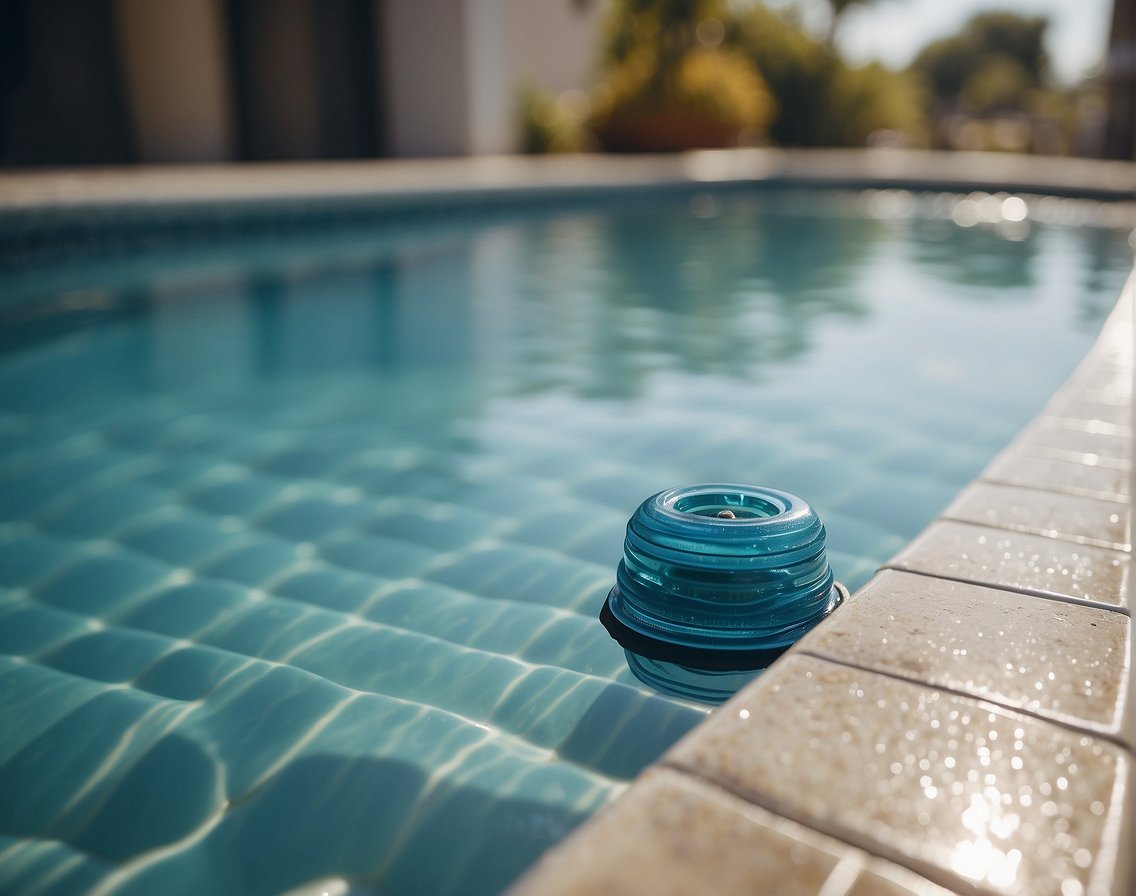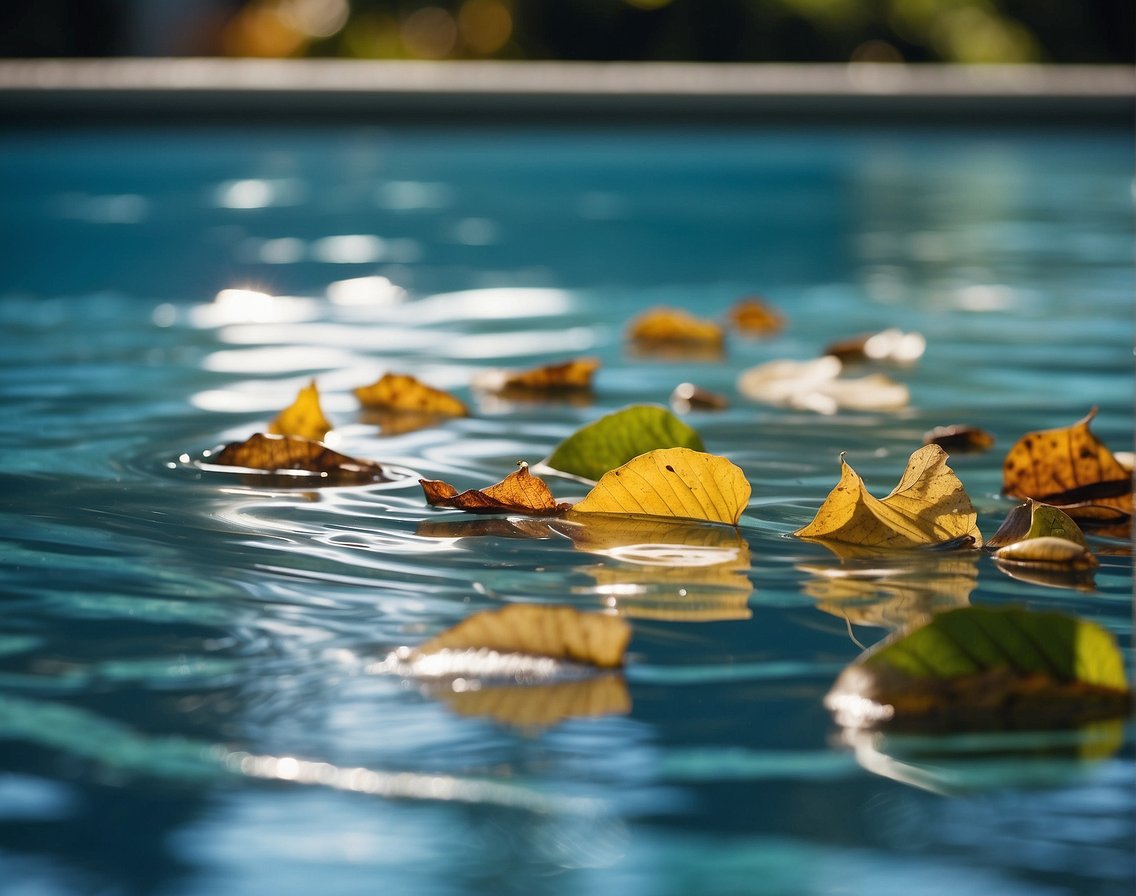Understanding Pool Skimming

Pool skimming is essential for maintaining water quality and clarity by removing surface debris efficiently.
Role of Skimming in Pool Maintenance
Skimming is a critical first step in pool maintenance. It targets floating debris on the pool surface before it sinks and becomes more challenging to remove. Regular skimming improves water clarity and prevents the spread of contaminants, contributing to a healthier swimming environment. By engaging in daily skimming, we reduce the strain on the pool’s filtration system, increasing its effectiveness and lifespan.
Types of Pool Skimmers
- Manual Skimmers: Typically consist of a skimmer net attached to a telescopic pole, used to manually remove debris from the water surface.
- Built-in Skimmers: Installed in the pool walls, these skimmers draw water from the surface into a skimmer basket to trap debris.
- Above Ground Pool Skimmers: Usually hung over the pool’s edge or attached to its side, these are less permanent but essential for pools without built-in options.
Components of a Pool Skimmer
Skimmer Basket: Positioned inside the skimmer, it collects and holds debris, preventing clogs further down the system.
Weir Door: A small, flap-like door, it facilitates a consistent flow of water and debris into the skimmer.
Skimmer Lid: Serves as a safety feature and provides easy access to the skimmer basket for cleaning.
Skimmer Line: Connects the skimmer to the filtration system, and includes:
- Suction Line: Draws water and debris into the skimmer.
- Equalizer Line: Prevents air from being drawn into the system if water levels drop.
Vacuuming systems may also connect to the skimmer line, leveraging its suction power to clean the pool’s bottom and sides. Regularly checking these components ensures the skimming process remains efficient and effective.
Maintaining Your Pool Skimmer

Proper skimmer maintenance is crucial for a clean pool and efficient pool care duties. By conducting routine cleaning and addressing common issues, we ensure our pool remains a pristine oasis.
Routine Cleaning and Inspection
To keep your pool’s skimmer functioning effectively, we prioritize regular maintenance. Each week, we should:
- Inspect the skimmer basket and remove any debris.
- Check for cracks and damage to the skimmer basket.
- Wash the basket with a hose to remove finer particles.
- Examine the weir, which is the flap door that keeps debris inside the skimmer, ensuring it moves freely.
- For optimal water level, maintain it at about 1/2 to 1/3 up the skimmer opening.
Monthly tasks include:
- Inspecting the skimmer gasket and O-ring for wear and replacing if necessary to prevent air leaks.
- Brushing down the skimmer walls to prevent algae growth and contamination.
- Ensure that skimmer screws and fittings are secure.
Regular filter cleaning, backwashing, and monitoring pH levels will also support the skimmer’s efficiency in removing debris.
Troubleshooting Common Skimmer Issues
Our skimmer can face issues that need immediate attention:
- Clogging: If water flow decreases, check for clogs in the basket or pipe. Turn off the pump before removing the basket to clear obstructions.
- Air Leaks: If there are bubbles in the pump basket or coming out of the return lines, inspect the skimmer gasket and O-ring. Replacing them can resolve air leaks.
- Water Level: Adequate water level is necessary for the skimmer to work properly. Too low, and it can’t draw in debris; too high, and it becomes inefficient.
- Worn Parts: Regularly check for wear and tear on the skimmer parts. Replace them when they show signs of damage to maintain the skimmer’s functionality.
By diligently performing these maintenance and troubleshooting steps, we keep our pool cleaning regimen intact and our swimming area inviting.
Integrating Skimming with Overall Pool Care

Effective skimming forms a foundational element in pool maintenance, contributing to water clarity and preventing debris from affecting water balance and filtration systems. We aim to synchronize skimming with various aspects of pool care to maintain an inviting and debris-free environment.
Balancing Chemicals and Skimmer Efficiency
Regular skimming improves the efficiency of pool chemicals by removing contaminants that can disrupt water balance. By preventing debris from decaying in the water, we ensure that pH levels and alkalinity stay within optimal ranges, thus reducing the need for corrective chemicals, and consequently, maintenance costs. To illustrate:
- Optimal pH Level: 7.4 – 7.6
- Ideal Alkalinity Range: 100 – 150 ppm
Keeping the skimmer basket clear enhances its ability to distribute chemicals like chlorine more effectively.
Enhancing Water Circulation and Filtration
Proper skimming is crucial in aiding water circulation and enhancing the filtration process. By removing leaves, bugs, and other debris before they sink and clog the main drains, we ensure that the filtration system operates efficiently:
- Pool Pump Basket: Checking and emptying regularly for unobstructed water flow
- Pool Filter: Maintaining cleanliness to uphold filtration capacity
Circulation patterns are optimized when skimmers are unblocked, distributing pool chemicals evenly and maintaining water clarity.
Long-Term Impact of Skimming on Pool Health
In the long term, skimming extends the lifespan of pool equipment and reduces algae growth by inhibiting organic material from settling and decomposing. This consistent attention to removing debris plays a vital role in maintaining pool health:
- Water Clarity: Prevents cloudiness and preserves inviting appearance
- Maintenance Costs: Minimizes the need for costly repairs due to clogged parts
Seasonal Skimming Considerations
As seasons change, the frequency and approach to skimming may require adjustments. During swim season, daily skimming combats increased use and environmental factors such as sunscreen and pollen. In contrast, the presence of trees might necessitate more frequent skimming in the fall, while rain can introduce additional contaminants.
- Summer: Pay extra attention to sunscreen oils and insects.
- Autumn: Leaves and organic debris are more prevalent.
- Winter: Skimming remains important to manage storm runoff and debris.
Adapting our skimming practices to the season is essential for ensuring a debris-free pool year-round.
Strategic Approaches to Skimmer Use

In our quest for a clean and inviting pool, integrating strategic skimmer use into our routine maintenance is critical. We’ll explore how to optimize our approach to skimming, balance it with other cleaning duties, and keep maintenance costs in check, all while enhancing efficiency and extending equipment lifespan.
Optimizing Skimming Frequency
To ensure water clarity and prevent debris buildup, we establish a pool maintenance schedule that includes daily skimming as fundamental. During peak season, or after events like storms, which bring extra leaves and debris, we might increase the frequency. Regular skimming maintains a pristine surface and eases the burden on the filtration system.
Integrating Skimming with Pool Vacuuming
We coordinate skimming with pool vacuuming to maximize cleanliness. Skimming should precede vacuuming to remove floating particles that can sink and complicate vacuuming. This integrated approach promotes a more effective clean and can reduce the need for additional vacuum passes, saving time.
Adjusting Skimmer Settings for Different Conditions
Skimmer efficiency can vary with changes in pool usage and weather conditions. After rain, we adjust the skimmer valves to manage increased water levels and debris. Moreover, we tailor the skimmer settings to maintain optimal flow, ensuring debris is captured effectively without overworking the filter.
- Normal Conditions: Skimmer valve settings at standard positions.
- After Rain or High Wind: Increased skimmer suction to handle excess debris.
- High Pool Use: Enhanced skimmer action to remove oils and contaminants.
Cost-Effective Skimmer Practices
Maintaining our pool skimmer isn’t just about cleanliness; it’s also about cost-effectiveness. We clean skimmer baskets regularly to prevent clogs and maintain the efficiency of the filtration system. By keeping the pool skimmer well-maintained, we can prevent costly repairs and extend the lifespan of our pool equipment.
- Regular cleaning of baskets: Reduces strain on pumps and filters.
- Inspection of skimmer weirs: Ensures optimal flow and catching of debris.
- Proactive maintenance: Prevents costly repairs and maximizes equipment lifespan.
Additional Pool Skimmer Enhancements

Pool maintenance is not just about keeping the water chemically balanced. A clean pool also demands regular debris removal to maintain its aesthetic and functional appeal. We can significantly enhance this facet of pool care with specific accessories designed to boost the skimming process’s efficiency.
Accessories for Improved Skimming
To maximize the effectiveness of our pool skimmers, it’s important to consider the various accessories that complement our existing pool equipment. Here are some targeted enhancements:
- Skimmer Basket: Upgrading to a higher quality skimmer basket can aid in capturing more debris before it settles on pool surfaces. A sturdy basket with fine mesh can trap both large leaves and smaller particles.
- Weir: Installing a skimmer weir helps to improve water flow into the skimmer, increasing the rate of debris capture for more efficient skimming.
- Telescopic Pole: A strong and extendable telescopic pole allows us to maneuver the skimmer net across the entire pool, ensuring that every spot gets attention.
- Skimmer Net: A fine-meshed skimmer net is crucial for manual skimming. The quality of the net material can greatly impact its lifespan and debris capture rate.
When these accessories are used in conjunction, we ensure a cleaner pool that requires less vacuuming, thereby enhancing our relaxation time. Regularly inspecting these accessories for wear and tear, and replacing them as necessary, guarantees that our skimming process maintains peak efficiency.
Frequently Asked Questions
In this section, we address common inquiries that pool owners have regarding the significance of skimming in pool maintenance and how to effectively implement this crucial task.
Why is skimming important in swimming pool maintenance?
Skimming is a vital step in maintaining a pool’s health and aesthetics. It involves removing debris from the water’s surface before it sinks, which helps prevent clogging of the pool’s filtration system and reduces the need for chemical treatments.
How does a pool skimmer facilitate cleaner water?
A pool skimmer captures leaves, bugs, and other floating debris from the surface. This pre-filtration process helps ensure cleaner water by trapping contaminants before they can decompose and affect water clarity and balance.
What are the best practices for using a pool skimmer effectively?
To make the most of a pool skimmer, ensure it is not obstructed and the basket is emptied regularly. Position floating skimmers strategically where the debris naturally gathers and adjust the water level to the skimmer’s optimal range for maximum efficiency.
Can a pool maintain cleanliness without a skimming process?
A pool cannot maintain optimal cleanliness without skimming. While filtration systems manage smaller particles and chemicals treat microorganisms, skimming is essential for removing larger debris and preventing filtration system overload.
How often should the pool skimmer be operated for optimal results?
We recommend running the pool skimmer daily, especially during high usage or after windy conditions which increase debris. During peak swimming season, more frequent skimming might be necessary to maintain water clarity.
What are the consequences of not using a pool skimmer regularly?
Neglecting the use of a pool skimmer can lead to cloudy water, clogged filtration systems, and increased chemical demand. The unchecked accumulation of organic materials can also promote algae growth and create an uninviting swimming environment.
